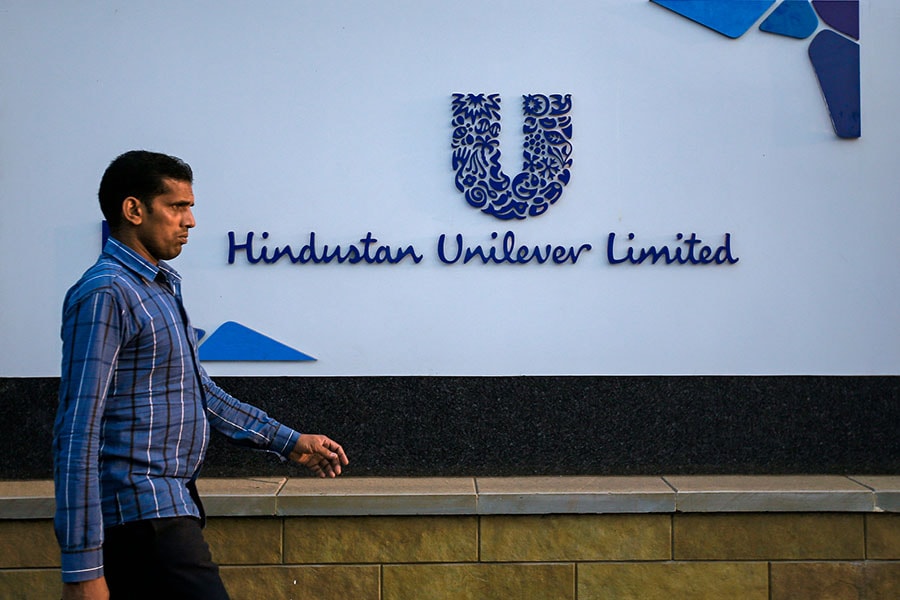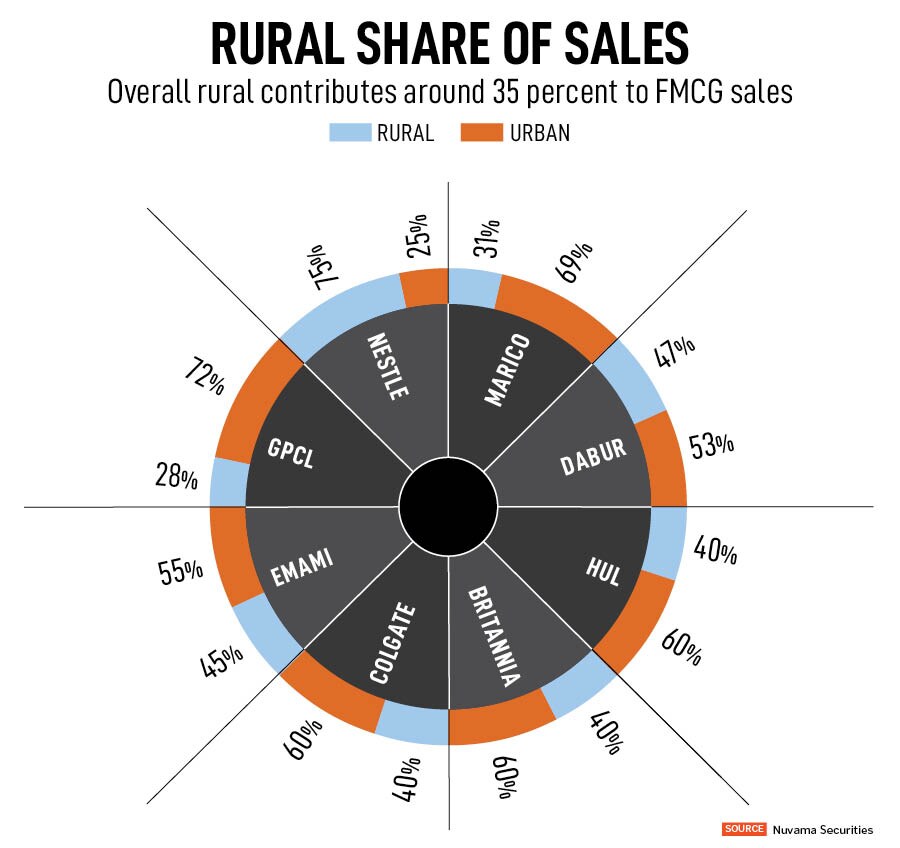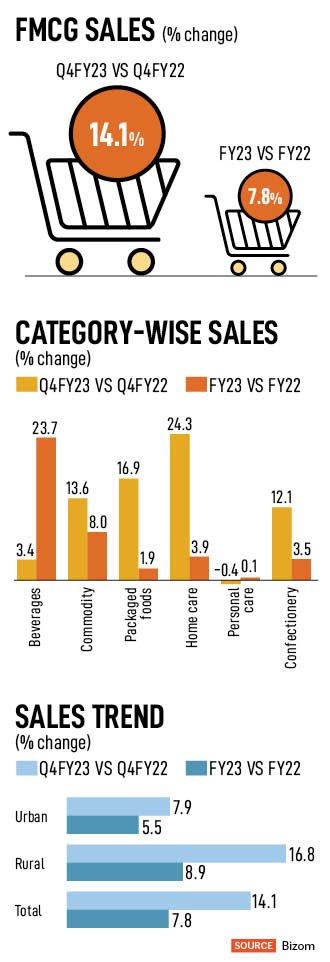Is the worst over for India's rural economy?
Lower inflation, a good harvest, and continued government spending on rural infrastructure will see demand pick up in India's villages in FY24


After hitting a rough patch for 18 to 20 months, rural demand is beginning to return. India"s villages contribute more than 35 percent to overall annual FMCG sales, as per various estimates, and are therefore crucial for the overall revival of the sector.
According to Bizom, a retail intelligence platform that tracks consumer product sales across 7.5 million outlets, rural consumer goods sales rose by 16.8 percent in the quarter ended March 31 (Q4), marking an 8.9 percent growth for the full financial year (FY23). Urban sales, on the other hand, grew by 7.9 percent in Q4, ending the full year with 5.5 percent.
Overall, FMCG sales, urban and rural combined, grew by 14.1 percent in Q4 and 7.8 percent in the full year, Bizom said.
Crisil Ratings’ estimates rural growth is outpacing urban growth by almost 2:1 in the last quarter of fiscal 2023, says Anuj Sethi, Senior Director of the rating agency.
Inflation is gradually cooling off from earlier highs. “The sluggish phase in rural growth appears to be behind us," says Sethi.
The reasons for the uptick in rural demand are several. First, inflation is cooling off from earlier highs. “The worst is behind us," says Sethi. Second, commodity prices have softened, including crude, palm oil, wheat and packaging materials. High milk prices, however, are a cause of concern for companies like Nestlé India which is seeing a squeeze in margins in its chocolates and confectionary division, as well as its dairy business which makes Milkmaid condensed milk and Everyday dairy whitener. Third, better crop yields are leading to better farm incomes. As per the second advance estimates released by the government for 2023, Rabi foodgrain and oilseeds output are projected to reach a record high. “With higher overall foodgrain production, we expect farmers’ income to remain solid," says Abneesh Roy, executive director, Nuvama Institutional Equities.
FMCG company chiefs, however, are seeing mixed results from rural markets.
 Nestlé India saw revenue from operations climb to Rs 4,808 crore in the quarter ended March 31, up by 21.3 percent a year earlier. Image: Sajjad Hussain/AFP
Nestlé India saw revenue from operations climb to Rs 4,808 crore in the quarter ended March 31, up by 21.3 percent a year earlier. Image: Sajjad Hussain/AFP
Nestlé India, for example, which sells Maggi noodles and Nescafe coffee, saw revenue from operations climb to Rs4,808 crore in the quarter ended March 31, up by 21.3 percent from a year earlier. Profit rose by 25 percent to Rs737 crore from Rs591 crore a year earlier. Suresh Narayanan, managing director of the Swiss giant’s India unit, attributed this to price hikes as well as increased demand from rural regions.
“Rural growth was also strong, secular and robust, being volume led," Narayanan said in a statement. The rising demand for small packs of coffee and noodles, and a move to expand its distribution network have lifted rural sales over the last few quarters.
 HUL reported a 10.6 percent rise in revenue to Rs14,638 crore, and a 10 percent jump in profit to Rs2,522 crore in the quarter ended March 31. Image: Danish Siddiqui/Reuters
HUL reported a 10.6 percent rise in revenue to Rs14,638 crore, and a 10 percent jump in profit to Rs2,522 crore in the quarter ended March 31. Image: Danish Siddiqui/Reuters
Hindustan Unilever (HUL), meanwhile, was more cautious in its market outlook. The rural slowdown was “bottoming out", said outgoing CEO Sanjiv Mehta during a press conference announcing the Q4 results. HUL reported a 10.6 percent rise in revenue to Rs14,638 crore, and a 10 percent jump in profit to Rs2,522 crore in the quarter ended March 31. Volume growth, meanwhile, was muted at 4 percent for the quarter as rural consumers down-traded to cheaper alternatives to deal with inflationary pressures. “Market volumes will recover gradually as consumption habits readjust," Mehta said.

Overall, for the consumer goods industry, quarterly volumes in rural markets declined by 3 percent year-on-year (Y-o-Y), while for the full year, they declined by 7 percent. “Rural continues to be shaky with volume growth still not positive. However, the extent of decline reduced during the quarter," says Amnish Aggarwal, head of research at Prabhudas Lilladher. Certain categories like packaged goods and home care have seen better recovery than others like personal care.

A further drop in raw material prices, cooling inflation and increased government spending on rural infrastructure in the run-up to the general elections next year will further help volume recovery, Aggarwal says.
 FMCG volume growth should be “at least 4 to 5 percent" even as commodity prices remain steady only then the “volatile scenario can turn a corner", said Mehta.
FMCG volume growth should be “at least 4 to 5 percent" even as commodity prices remain steady only then the “volatile scenario can turn a corner", said Mehta.
Similarly, Marico in its Q4 update—ahead of its results announcement on May 5—said that the sector continued to witness a “gradual recovery" with Y-o-Y volume trends improving in each quarter. The company saw 3 to 4 percent volume growth in Q2 and Q3 of FY23, and will report mid-single-digit volumes growth in Q4. This has come on the back of strong performance in key product categories such as Parachute Oil, which saw high single digit volume growth. “Stable and range bound copra prices helped achieve this," says Roy of Nuvama Securities.
“While urban and premium categories were stable, an easing of broader commodity inflation bodes well for overall consumption trends, especially in rural markets," said Marico. Further, a more “visible" and “sustained" recovery in FMCG demand will be seen in the coming quarter.
Dabur India was similarly subdued in its rural sentiment in its Q4 update. The maker of Vatika hair oil and Dabur Honey noted that the demand trajectory in both urban and rural areas showed a slight improvement sequentially compared to Q3, but it fell short of a full recovery.
“It will take another three to four months for a full-blown recovery in rural markets," says Aggarwal.
Good rains will be key to that. Lack of rain could reduce crop yields, drive up food prices and stoke inflation.
“India has had normal monsoon for the past four years, and the odds of a fifth consecutive normal monsoon look muted," says Roy. Besides the fear of El Nino playing out looms large. A climate pattern that leads to a hotter summer and weaker monsoon, El Nino could “derail recovery" in rural FMCG, he says, adding that the outlook will get better in FY24.
First Published: May 03, 2023, 14:30
Subscribe Now